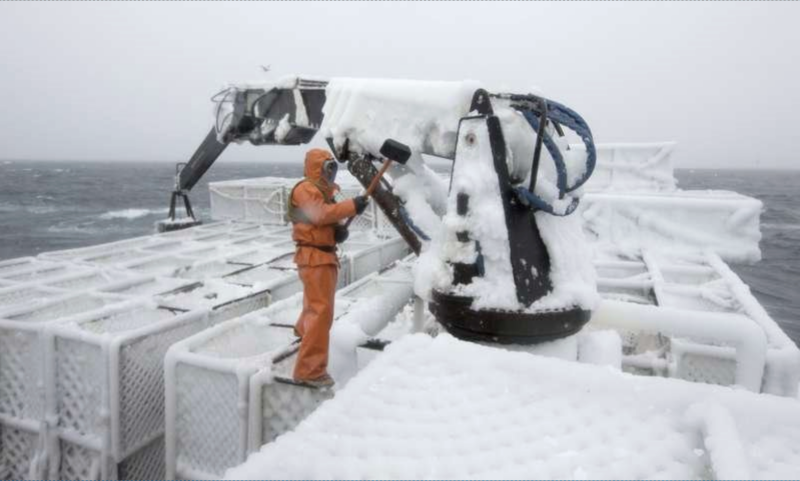It has been five years since the loss of the Alaskan king crabber, Scandies Rose, and seven since the loss of the Destination. Both vessels were loaded with crab pots that exceeded estimated weights in their respective stability calculations, and both capsized while facing difficult weather conditions.
“The loss of the Destination and the Scandies Rose was a double gut punch to the industry,” says John Myers, co-owner of Hockema Group a highly regarded naval architecture and marine engineering firm in Seattle. “But in the intervening years, nothing has been done in terms of regulations. In 2010, Congress mandated stability training, but that has not been implemented by the Coast Guard. At present, there is no formal review process for stability calculations for non-processor crab vessels or the overwhelming majority of fishing vessels in Alaska.”
“We’re still operating under the same stability regulations that have been in place since 1991,” says Hal Hockema, the company founder. “They’ve been refined in small ways but are essentially the same.” Some have called for an overhaul of the regulations, making them stricter, but Hockema believes they are sufficient if applied in the right way.
“If your calculations are based on a 650-pound pot, and that jumps to 800, you’re asking for trouble,” says Hockema. “And generally, we don’t put on all the pots we can when calculating for icing. We’ll take a tier off.” Hockema adds that he is not aware of any vessels that have sank when accurate calculations are used to meet the 1991 Coast Guard standards.
Myers points out that due to the actual weight of the pots it had on deck, the Destination was out of compliance with the standards they used at Hockema Group before it left port. “The Coast Guard does make spot checks of vessels and can stop them from leaving if the number of pots doesn’t conform to the vessel’s stability calculations,” he says.

According to Scott Wilwert, Commercial Fishing Vessel Safety Coordinator of the USCG, in the late 90s, the service asked for two state statutes. “One requires a mandatory call to the Coast Guard before a vessel in the Bering Sea/Aleutian crab fishery leaves port,” he says. “That’s mandatory. Then we can swing down and look things over. We can see how they’re loaded and weigh a few pots. We assist in reviewing the vessel’s stability instructions to verify how the vessel is loaded. That’s optional, but in reality, everyone says yes. The other statute requires these vessels to have a fishing vessel safety decal.”
Myers’ experience in recent years also reveals a greater interest in safety. “Where we’re seeing change is in individual awareness. Our phone is ringing with vessel owners who know their stability booklets are out-of-date and want them updated.”
To further help increase awareness, Hockema Group offers a 4-hour stability training program in Seattle at the same time as the Pacific Marine Expo. “We’re right across the street at the Silver Cloud Hotel, Friday the 22nd of November at 8:00 AM,” says Myers. “We look at all the variables of stability and other important factors such as watertight integrity and downflooding, due to things like open doors and hatches. The Arctic Rose was lost in 2001 along with its 15 crew members due to a watertight door being tied open that couldn’t be closed quickly.”
Myers explains that the objective of the course is to raise stability awareness among all crewmembers, not just captains and owners. “Stability is the responsibility of everyone on the vessel,” he says. “Especially the engineers, who ought to be the most aware of fluid levels, the state of valves, vessel trim, free-surface, condition and maintenance of closing devices, and more.”
With the accuracy of weather reporting in 2024, Hockema suggests that vessels pay attention and stay in port if severe weather and icing are predicted. “If you’re looking at severe icing conditions, don’t go,” he says, noting that crabbers are particularly vulnerable to sudden changes because they take on pots in port and then may have a 24-hour or more steam to their fishing grounds.
Myers recommends having pots weighed for accurate calculations. “Sometimes they’ll add steel for reinforcement. We weigh them with all associated gear: ropes, buoys etc,” he says. “This is a very important issue. I think the industry understands that, and we’re doing all we can to raise awareness.”
The industry and regulatory bodies, such as the Coast Guard, must collaborate to address stability among these fishing vessels, ensuring that all operate under rigorous, up-to-date safety standards to prevent future tragedies.







